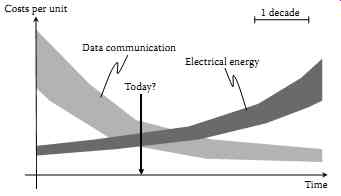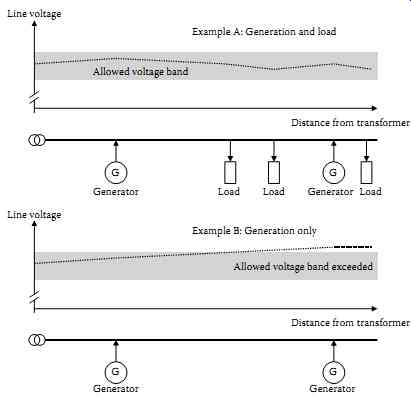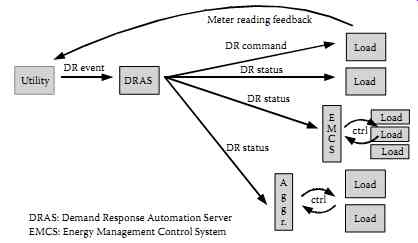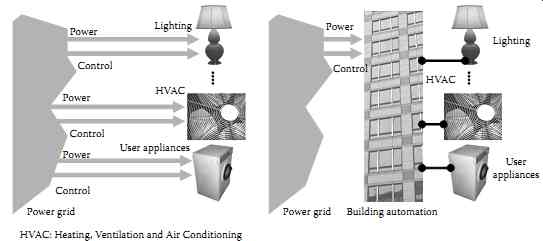AMAZON multi-meters discounts AMAZON oscilloscope discounts
Energy distribution has mainly been a domain of power electronics, but not of industrial communication systems in the past. However, in the light of climate change and strong efforts to reduce CO2 emissions, the concept of "smart" energy distribution and "smart power grids" has emerged. Such smart grids are defined through the combination of power and information as well as communication technology, whereas the latter allow smart control algorithms to be applied. This section describes the motivations, drivers, developments, and implications of smart grids.
1. Evolution of Smart Energy Distribution
The electrical power systems as they exist today are the result of more than 100 years of technical development.
Since Edison's first installations, the guiding design principle was that of large central power plants and a large number of small distributed consumers, which are connected with the generation sites by means of a power grid. For availability reasons, isolated systems got connected and large national and transnational grids evolved.
The electric power grid is a classical distributed system, even if it is not consisting of computers but of electrical generators and loads. Seen from an abstract viewpoint, it consists of a large number of interacting entities (nodes or energy resources) that are connected with communication channels, the power lines. Communication is realized by influencing and observing ubiquitous physical parameters like power flows or the grid frequency. The growing power grid was, together with the telephony system that had its growing period nearly at the same time, one of the first and largest distributed systems that have been designed by electrical engineers. This duality of key infrastructure systems, one for electrical energy and the other for communication, which began in the 1880s and 1890s, still exists today. However, while the telephone system has merged into the Internet and thus made through a number of revolutionary technological changes, the power system has remained with comparably little changes. The primary reason for this is that changes in the power grid are associated with extraordinary high investment costs (compared to those of smaller components in the telecom sector), resulting in long investment cycles of several decades.
The electric power grid cannot store electrical energy in large amounts for long times. The generated power has to match the consumed power at all times. In some way, the current demand has to be communicated to the generation sites, so that they can adjust to it (theoretically, also the generation amount could be communicated to the loads so that they would adjust to it). Further, a suitable way of load-sharing between the generators is needed, which can be seen as a protocol that determines in detail which generator reacts when and how much. All this has to work over hundreds or even thousands of kilometers. This technical challenge was brilliantly met without the use of any explicit data communication by the introduction of power-frequency control. Today, however, information and communication technology (ICT) is seen as one of the key concepts to maintain efficient and secure provision of electrical energy. The reason for this is a paradigm shift: In addition to the centralized generation, smaller generation units in larger numbers are more and more integrated into the grid, the so-called dispersed or distributed generation. Electricity generation from renewable sources is often only realizable as distributed generation.
This is because compared to the traditional generation from fossil resources, the energy density of renewable energy sources is low. The number of generation units is comparably high, but they have a rather low individual power output compared to large centralized power plants. Units are set up at locations where the availability of the energy source is good (e.g., strong winds, flowing water). This results in generation units being scattered over the power grid infrastructure in a spatially distributed manner. It can be argued that a more distributed organization of the power infrastructure is also going along with an increase in reliability. Bottlenecks can be avoided and regional electricity supply can be maintained using local sources even if the backbone grid fails. This, however, can only be achieved with more complex system operation basing on an extensive use of automation infrastructures.
The integration of a high density of distributed generation into the existing power grids leads to a number of different issues. The two most prominent ones are the fact that generators connect to the grid at positions that have initially been designed for loads only and the volatile nature of generation from renewable sources. The strong growth of electricity generation in the medium voltage grid, where most of the installed distributed generation injects its power, leads to grid voltage problems. In times of low demand, the grid voltages at the feeding points reach the limits set by grid operators and regulation authorities, so that no more units could be installed without significant grid investments.
The second issue is that due to the volatile nature of generation from renewable energy resources, it becomes more and more difficult to predict the amount of electricity generation. As a result, in future there will be a stronger need for balance energy. Especially the rising amount of distributed generation will significantly increase the uncertainty in balance prediction and therefore increase the need for more balance energy provision.
Therefore, the rising energy demand and the necessity to increase energy efficiency and generation from renewable resources imply that power quality and security of supply can only be maintained (before even improved) if the basic management mechanisms of the power grid are adapted to the changing situation. This results in the need for large investments and a number of innovative technical solutions. The "smart power grid" serves as the umbrella for a harmonized and coordinated application of such new technical solutions, which heavily rely on ICT ( FIG. 1).
Smart power grids can be defined as in: "Smart grids are power grids, with a coordinated management based on bi-directional communication between grid components, generators, energy storages and consumers to enable an energy-efficient and cost-effective system operation that is ready for future challenges of the energy system." There are two key drivers for the development of smart grids. The first is the integration of renewable energy resources into the power grids, as mentioned before. The second is the advance in ICTs.
Innovations in communication systems, especially in the areas of signal processing and in production technologies, have resulted in the deployment of communication systems that enable comparably high data throughput for low costs. Wireless transmission of data is state of the art at this stage for remote control in medium voltage grids, a fact that shows that this technology has reached an adequate level of maturity and is accepted by the grid operators, who traditionally are very concerned about the reliability of information technology in the grid. The technological advance on the side of information technology on one hand and the beginning shortage in energy supply (including the need for CO2 reduction) on the other hand also result in an economic paradigm shift: As costs for energy rise and costs for communication fall, the relation between both begin to change and the unit cost for energy is ultimately becoming higher than the unit cost for communication in many application areas ( FIG. 2).

FIG. 1 Definition picture of a smart grid. (National Technology Platform-Smart
Grids Austria.

FIG. 2 Estimated development of costs for communication and energy.
2. Key Concepts of Smart Grids
Smart grids are made out by the application of a number of key concepts that are discussed in the text following. All of them need an underlying industrial communication infrastructure, which can be affordable when deployed for multiple applications.
Supervisory control and data acquisition (SCADA) and substation automation are the traditional domain of narrowband automation infrastructure in power grids, especially in medium and high voltage grids. The SCADA infrastructure is used to connect network components in the field with control centers, so that they can be supervised and remote-controlled. The media used for SCADA can be very diverse and span from glass fiber over wireless solutions to distribution line carrier, a special form of power line communication for medium voltage grids.
Substations are currently the endpoint of the utilities' automation infrastructure. From this point on, there is usually no more online data coming from the grid. This situation is going to be changed by AMI (automated metering infrastructure) or similar initiatives. The problem, however, with existing substation automation and communication is that many are based on proprietary technology. This is now changed by IEC 61850 [IEC05]. Several existing efforts (EPRI UCA 2.0, IEC 60870) are converging to one unified standard for telemetry and remote control. It is specifically designed for local area networks like Ethernet and therefore more than an encapsulation of control commands. Using a substation bus (10 Mb/s to 1 Gb/s) and a process bus (100 Mb/s to 10 Gb/s), it connects meters, protocol relays and converters, human machine interfaces, and substation equipment. It uses a strictly object-oriented approach to model the application and has types and formats for all necessary data. Peers are either in a client-server or multicast relation and exchange information via messages. The protocol stack offers slim and real-time-capable transports as well as interoperable, IP-based services. The fast services have direct access to the data link layer, while all others use a sophisticated protocol stack that ensures easy management and commissioning.

FIG. 3 Voltage over a feeder in the presence of loads and generators.
In Example A, voltage limits are not exceeded. In Example B, no load
reduces the voltage, but generation is still active (e.g., in a night
with strong winds).
Without active generation management, the generators would be disconnected from the line by voltage protection switches.
Active distribution grids allow the integration of a high density of distributed generation in existing medium voltage infrastructure by an active control of generation power on the basis of voltage or power flow measurements at critical points in the grid. As shown in FIG. 3, the main barrier for connecting new generators to the grid is that power feed-in increases the grid voltage at the feed-in point.
The voltage has to be kept in an allowed band (e.g., ±10% of nominal value) by the grid operator in any case. The worst case occurs when there is no load but strong energy generation on the feeder, as shown in FIG. 3, Example B. In an active distribution grid, the generation of the distributed generators is managed according to the voltage at critical points. If the voltage rises too high, reactive power management is performed. If this is not effective enough, even the active power can be curtailed.
Such an active management of generated power in a medium voltage feeder is basically a form of multi-objective control. The challenge here is that sensors, controllers, and actuators are very far from each other. Voltage and power information has to be communicated over dozens of miles once every 6 s or so. The automation infrastructure used has to be highly reliable. Often, the protocols are transported over a variety of different media, depending on the available communication links.
Smart meters can be part of a smart grid, but they are not the same as smart grids. Although the origins of smart metering technology lies in remote meter reading, other aspects also play a role in smart meters than consumed kilowatt-hours. These are consumption profiles, power quality monitoring, and remote switching of loads.
It can be expected that power grids will in future be operated closer to their limits as it is currently the case. One of the reasons for that is that the pattern and kind of investments into the grid infrastructure will change due to the liberalization of power markets. For maintaining the high standards in power quality, today it is already considered to be necessary to monitor power quality variables such as voltage, flicker, and harmonics using online measurements in the grid. This is another driving factor for an increasing flood of online measurement data from the grid.
Smart metering systems can generate snapshots of the consumption state of the whole grid so that grid operators can examine in detail how much power was flowing to where in the moment of the snapshot. Therefore, smart meters are interconnected by means of communication links, usually narrowband power line communication to data concentrators at the transformer stations. From here, backbone networks (e.g., glass fiber) bring the data to control centers. Communication infrastructures are essential features of smart metering systems, but in many grids they are still nonexistent.
While in some countries smart meters are area-wide deployed, in other countries the debate about their benefits is still underway. On the positive side, these systems simplify the accounting and consumers can be promptly informed about their energy consumption. More data are available from the grid, and network development planning can be done on the basis of real data instead of worst-case models. Failure detection becomes easier and voltage bands can be used more efficiently. On the negative side, the costs are very high and it is basically assumed that the consumer will pay the price. Further, there is a severe lack of standards. Long-term reliability and data security questions are not yet completely answered.
One of the largest projects about smart metering in the United States is the AMI initiative; similar projects exist around the world. AMI is seen as the next step after remote metering: bidirectional communication between utilities, customers, and grid operators. The main concerns of AMI are affordable and secure acquisition and management of billing-relevant data. Although usually considered as non-critical transport, there are high requirements in accuracy and reliability. The expectations toward AMI are:
• Reduced management costs for billing
• Increased insight into consumption patterns
• Reduced energy consumption because of immediate feedback information to the customer
• Identification and correction of leakages and losses
• Improved grid stability due to integration with demand response programs The communication technology for AMI is typically separated into two parts. The wide area link is classically based on Internet technology, transported over UMTS, DSL, and other available Internet connections.
Inside the customers' facilities, the choice often lies on wireless home networks, for instance based on ZigBee or Z-wave.
Automated demand response (DR), that is, remote switching of customers' appliances, plays a key role in most smart grid conceptions. A number of different terms are used in this context, such as demand side management, DR, or load shifting. The general idea is to gain influence on the load side of the power grid and make use of flexibilities in the timing of energy consumption. Such measures are seen as a supporting tool to match supply and demand under the condition of supply from fluctuating renewable energy resources, whose generation patterns do not match the demand curves. In countries with a high blackout frequency, DR can be a key concept to better distribute the available generation and transmission capacities.
Load shifting, in particular, does not aim to reduce energy consumption in long term, but to reduce peak loads by shifting consumption to off-peak times. As a short-term method, it allows improving the balance of supply and demand without the decrease of functionality for end users. Modern load shifting happens hidden and unrealized by the energy subscriber. The control of load shifts, distributed storages, and curtailment of interruptible loads are the major tools for this strategy. Based on their specific processing, properties, and energy storage functionality, there is the possibility to reschedule energy consumption of certain loads. Energy can either be stored in real energy storages, such as thermal storages, or as conceptual energy storages that can be exploited by rescheduling a process to a later point in time (load shift). Load shifting can be performed in various processes, for example, washing, cleaning, heating, chilling, and pumping. These electricity-consuming processes have, depending on the application, certain degrees of freedom in their time schedule. Many representatives of these classes of potentially shiftable loads can be found within buildings, especially large functional buildings.
DR is taking influence on loads, for the benefit of the grid or the customer's energy bill. While demand response can refer to either incentive-driven (e.g., by time-of-use tariffs) or automated means to change the behavior of electrical loads, automated demand response implies communication from "the grid" to energy consuming appliances connected to the grid. The granularity of this communication could be reduced by addressing the whole building instead of every single part of equipment. Functional buildings account for a significant share of energy consumption and at the same time have usually large load shift potentials. Further, they are often equipped with building automation and control systems, which can interpret the demand response command from the grid and translate them into dedicated actions for the electrical consumers within a building. Therefore, the "building-to-grid" approach for demand response (FIG. 4) is very promising.
Automated DR is mostly load shedding, setpoint adjustments, duty-cycling, and load shifting, done in an automated fashion. So-called "aggregators"-service providers, mediating between a utility and customers-typically install such systems to manage their customers' facilities. The open auto-DR specification is the first attempt to standardize these systems.* Its core component is the demand response automation server (DRAS, see FIG. 5) and a set of standardized messages (events).
A utility or grid operator can issue a "demand response event" (e.g., a grid emergency) and depending on who subscribed to which demand response program, the DRAS distributes the required information to the clients (energy management control systems, aggregators, or directly the loads) in a secure and reliable manner. This concept can and will be extended to also serve developments like "Building2Grid" or "Plugin Hybrid Vehicles."

FIG. 4 "Appliance-to-grid" versus "building-to-grid" approach.
The granularity of this communication could be reduced by addressing
the whole building instead of every single part of equipment.

FIG. 5 Open auto demand response architecture.
3. Smart Grid Vision
The future smart grid will be characterized by an intensified flow of information compared to the state of the-art power grid, where the dominating flow of energy is only accompanied by sporadic (monthly or yearly) meter readings. The communication system will be used for many different applications ( FIG. 6), which altogether justify the large investments needed to build the infrastructure. The challenges for this development are not only of technical and economic, but also of organizational nature. It is hoped that by means of a smart infrastructure, an efficient and cost-effective power grid operation is achievable that is ready for future challenges of the energy system.
The actual realization of smart grids, however, is currently hindered by a kind of hen-egg-problem.
This is at least the case in central Europe. On one side, the common communication infrastructure is the defining element of a smart grid and serves for many smart applications. It is one of the key investments to be done. However, this investment is delayed because it seems to have no direct profit seen on its own. Also, the investor, who could be the grid operator, will only invest in an infrastructure that serves his or her own concerns (such as smart metering). Further services that he or she could provide for other stakeholders in the liberalized electricity market, such as plant operators, suppliers, or energy consumers, mostly cannot be paid regard due to the lack of standards of how such services should exactly look like.
====
Meter readings Active distribution grid control data SCADA Demand side management Online asset management Power quality data Maintenance data and others ICT Infrastructure of smart grid ICT: Information and Communication Technology

FIG. 6 Anticipated application data flowing over smart grid communication
infrastructures.
====
On the other side, the potential smart applications cannot or not efficiently be implemented without the basic communication infrastructure. Also, here, investments are delayed due to missing communication infrastructure.
A way out of this deadlock situation could be that a modular step-by-step strategy is developed that defines building blocks for basic and upgradable ICT services for smart grids, which can be used by all potential applications. Depending on the communication requirements of the applications, some applications can be used with the basic version and some only with upgraded versions of the ICT service set. For smart metering, for example, only small bandwidth connections with best-effort service are needed, while for active voltage control higher bandwidth and real-time service is required. Then, incentives for strategic investments by grid operators in the basic ICT services could be set. This approach would enable those applications with moderate service requirements to be realized and further lower the threshold for the implementation of applications with higher ICT service demand. The approach requires standardization of smart services and an upgradability of the ICT infrastructure to ensure that previous investments are still of use when the infrastructure is extended. It further requires actual communication components for smart grids that enable a step-by-step extension of the ICT infrastructure.